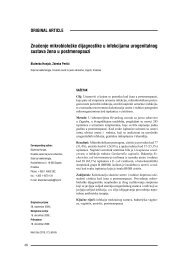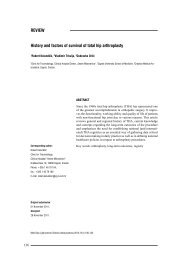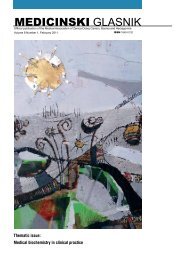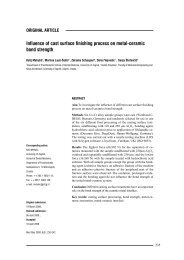MEDICINSKI GLASNIK
MEDICINSKI GLASNIK
MEDICINSKI GLASNIK
You also want an ePaper? Increase the reach of your titles
YUMPU automatically turns print PDFs into web optimized ePapers that Google loves.
14<br />
Medicinski Glasnik, Volumen 9, Number 1, February 2012<br />
LAPAROSCOPY BEFORE IVF?<br />
Many authors still support alternative diagnostic<br />
methods in the diagnostics of tubal pathology in<br />
everyday practice, such as HSG and Chlamydial<br />
antibodies, although laparoscopy represents the<br />
golden standard in the diagnostics of tubal and<br />
peritoneal pathology (41). Diagnostic laparoscopy<br />
can be avoided in cases of clearly confirmed<br />
diagnosis where IVF is considered as only successful<br />
treatment (5).<br />
However, many agree that in cases of adnexal<br />
pathology such as hydrosalpinx or endometriotic<br />
cysts, laparoscopic surgery is needed before IVF<br />
procedure (8).<br />
LAPAROSCOPY IN IDIOPATHIC INFERTILITY<br />
Nakagawa et al have studied the use of laparoscopic<br />
surgery in patients who were diagnosed<br />
with unexplained (idiopathic) infertility, comparing<br />
two groups: first those who underwent ART<br />
treatment without prior laparoscopy and the second<br />
group that underwent laparoscopy before<br />
any other ART techniques. They discovered that<br />
in 87.2% of the women, laparoscopy revealed abnormal<br />
findings; endometriosis lesions, peritubal<br />
adhesions and tubal obstructions. After laparoscopy<br />
48.9% of the patients achieved pregnancy,<br />
with the pregnancy rates ranging between 27.2<br />
and 100 % according to age groups. Authors recommend<br />
that laparoscopy should be strongly<br />
considered for examining women with unexplained<br />
infertility (42). Another Japanese group of<br />
authors has performed laparoscopies in patients<br />
with unexplained infertility. In their conclusion,<br />
they found no significance in pregnancy rates<br />
between patients who underwent IVF or spontaneously<br />
achieved pregnancy (43).<br />
AGE OF THE PATIENT AND LAPAROSCOPY<br />
There is general tendency of avoiding laparoscopic<br />
treatment in patients older than 35 due to<br />
the fact that their reproductive capacity is weakening<br />
with age (44). From our clinical experience,<br />
we have seen that many women are sent directly<br />
to the IVF centers, often with insufficient pretreatment<br />
diagnostics (11). The aforementioned<br />
studies indicate that there is a significant benefit<br />
for patients, if laparoscopy is performed, even in<br />
cases of unexplained infertility (42,43).<br />
The issue of ovarian reserve and functional fertile<br />
capacity of women can be easily resolved by<br />
determination of serum Anti Müllerian Hormone<br />
(AMH) level.<br />
Anti-Mullerian hormone is produced by the granulosa<br />
cells of the antral and preantral follicles and<br />
serum AMH levels reflect the ovarian pool of primordial<br />
follicles (44). Anti-Mullerian hormone<br />
levels remain stable during adulthood decreasing<br />
towards menopause (45)¸. Inter and intracycle<br />
variability of AMH is low enough to allow measurement<br />
at any time of the cycle. More importantly,<br />
AMH levels are not affected by contraceptive<br />
pills or GnRH agonists (46).<br />
Moreover, AMH is a good predictor of ovarian<br />
response in younger patients (45) and can also be<br />
a predictor of live birth as a result of IVF (47).<br />
Furthermore, AMH can be used as a marker of<br />
extensiveness of the endometrioma resection by<br />
its postoperative decline (48).<br />
The number of centers in our region in which<br />
AMH level can be determined is increasing.<br />
In conclusion, the routine use of diagnostic laparoscopy<br />
in evaluation of female infertility is<br />
still a matter of discussions. Current evidence<br />
shows that surgical treatment of minimal and<br />
mild endometriosis improves pregnancy rate.<br />
The European Society for Human Reproduction<br />
and Endocrinology (ESHRE) has recommended<br />
in its guidelines IVF as a suitable method of reproduction<br />
especially in cases of tubal pathology,<br />
severely reduced male fertility and more unsuccessful<br />
attempts of assisted reproduction (26),<br />
but laparoscopic salpingectomy is indicated before<br />
IVF procedure, if a hydrosalpinx is verified<br />
by ultrasound (15,17).<br />
The use of laparoscopy in diagnostics and treatment<br />
of tubal pathology is known and undisputed.<br />
Diagnostic laparoscopy is indicated in cases of<br />
bilateral anomaly seen on HSG.<br />
Role of laparoscopy in cases of unexplained infertility<br />
is still a matter of discussions, but some<br />
reported studies are in favour of diagnostic laparoscopies<br />
(42,43) Laparoscopic ovarian drilling<br />
does not have better influence on ovulation in<br />
comparison with gonadotropin use, but LOD significantly<br />
reduces the risk of multiple pregnancies<br />
when compared to gonadotropins, and reduces<br />
number of miscarriages and complications












